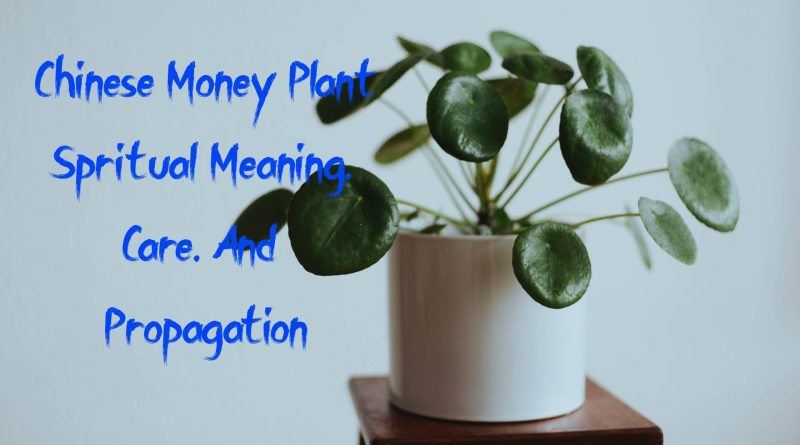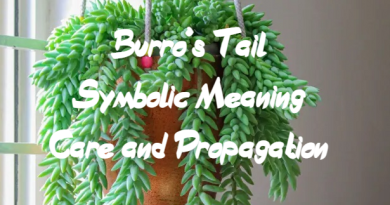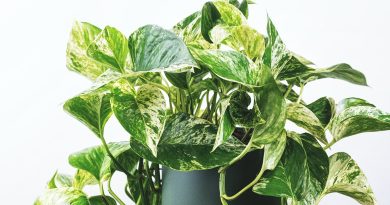Chinese Money Plant: Meaning, Care and Propagation
Chinese Money Plant (Pilea peperomioides) also known as “Coin Plant” is native to Southern China. It is a perennial in the stinging nettle family. It has a flat, round, shiny, leathery, thick and dark green leaves with a long, thin, red stems. This is a popular indoor plant. Chinese money plants are relatively easy to care for and can thrive in a variety of indoor settings.
They prefer bright, indirect light and well-draining soil, and should be watered when the top inch of soil feels dry to the touch. These plants are also known for their ability to propagate quickly, so they can be a great option for those looking to expand their plant collection. It purifies air when kept inside home or offices. Chinese money plants can grow up to 12 inches (30 cm) tall and wide, but they are often smaller when grown indoors. It is ideal for small spaces or as a decorative accent in a larger room.
Spiritual Meaning
The Chinese money plant is considered to be a symbol of good luck and prosperity. The round, coin-shaped leaves of the plant are believed to resemble coins and represent wealth, making it a popular gift and decorative element in homes and offices. It is believed to bring good luck, money and fortune to its owner. It also symbolizes the wish for financial stability and wealth.
In feng shui, the Chinese money plant is believed to bring positive energy and good fortune to a space. The plant is said to promote financial success, abundance, and prosperity, and is often placed in the wealth and prosperity area of a home or business. This plant is also believed to have spiritual significance as a symbol of growth and renewal. Its ability to produce small offshoots, or “pups,” that can be propagated and given to others is seen as a representation of abundance and generosity.
Care
Although Chinese money plants are generally easy to care for, they can be sensitive to overwatering and can develop root rot if the soil is too wet. Use proper draining pot for the proper growth of this plant. Here are some of the tips for proper care of Chinese Money Plant:
Light
It prefers lots of bright, indirect sunlight. Direct sunlight can cause their leaves to burn, so it’s best to keep them away from windows that receive direct sunlight.
Water
It’s important to let the top inch of soil dry out slightly between waterings, especially in winter season as overwatering can cause root rot. Water your Chinese money plant when the soil feels dry to the touch.
Temperature
It prefers temperature between 60-75 degree Fahrenheit. Keep them away from drafty areas, as they don’t tolerate sudden temperature changes.
Soil
Chinese money plants prefer well-draining soil. You can mix potting soil with sand or perlite to improve drainage.
Humidity
Chinese money plants prefer moderate to high humidity. You can increase humidity around the plant by misting it regularly, or placing a tray of water nearby.
Fertilizer
Fertilize it once during the growing season i.e. summer and spring with a balanced fertilizer.
Repotting
It can quickly outgrow their pots, so it’s a good idea to repot them every year or two. Use a slightly larger pot with fresh soil, and be careful not to damage the plant’s delicate roots during the transplanting process.
Propagation of Chinese Money Plant
It is very easy to propagate Chinese Money Plant as it naturally produces baby plant if the plant is happy and healthy. It produces baby plants on its stem and in the surrounding soil. Once the baby plant becomes big enough to function on their own, cut it with a clean and sharp knife beneath the soil. And simply pot these new plants in a new pot with moist soil.
Here are some other ways to propagate the Chinese Money Plant.
Leaf Cuttings
Step 1: Remove one leaf from the plant at the base using sharp and clean knife or a blade.
Step 2: Place the cutting in a bottle of water. Stem should be submerged.
Step 3: Roots will begin to appear in about two to three weeks. Once the roots are about a inch long, transplant it into a new pot with moist soil.
Stem Cuttings
Step 1: Cut the main plant off at its base with a clean and sharp knife or a blade.
In Water
Step 2: Place the cuttings in water to encourage root growth.
Step 3: Once the root grows, plant it in a proper draining pot with moist soil.
In Soil
Step 2: Plant the cutting directly into the proper draining pot with moist soil.
Health Benefits
Some of the health benefits of Chinese Money Plant includes:
It creates a calming atmosphere and reduces stress and also lowers the level of anxiety.
It is highly effective in improving air quality. Basically it removes the toxins, pollutants and harmful gases present in the air and makes homes or offices clean.
Another benefit is that it helps to boost productivity and memory.
Being around with this plant helps to improve the ability to complete tasks and concentrate.
Common Problems
Chinese Money Plant is low maintenance plant, but there are some common problems that may arise:
Leaves Turning Brown and Crispy at edges
This is a sign of underwatering or low humidity. Increase humidity levels around the plant and water it regularly. Exposing the plant to too much of direct sunlight causes crispy leaves. So, place the plant in bright, indirect sunlight.
Yellowing soft stems or black stems or Plant falling apart
This is caused by overwatering leading to root rot. Allow the soil to dry out thoroughly between watering.
Curling leaves or droopy leaves
It is caused by underwatering. So, water the plant regularly.
Doomed or curved leaves
It is often a sign of insufficient light. Make sure to place the plant in bright indirect light.
#The Chinese Money Plant is non toxic to pets and humans.
In Conclusion, this wonderful houseplant makes a positive addition to indoor spaces. It improves any room’s aesthetics and just looks good in any spaces at home and offices.
Enjoy Planting!!
Read Also:
15 Flowering Plants that Symbolize Love
Burro’s Tail Plant: Meaning, Care and Propagation




